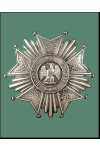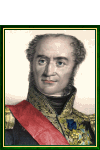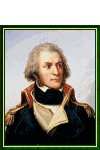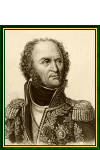Count of the Empire
Pronunciation:

Born on March 13, 1763 in Brive-la-Gaillarde, where his father was a lawyer and deputy public prosecutor, Guillaume Brune studied law in Paris. There, he discovered his literary vocation and became a typographer to support himself while writing his own work. It was published in 1788 under the title: Voyage pittoresque dans plusieurs provinces occidentales de la France.
The Revolution, which he fully embraced, turned him into a journalist. He set up his own newspaper, but soon had to give it up for financial reasons.
An active member of the Cordeliers district and a friend of Georges Danton since 1789, his political support earned him a lightning promotion when he embarked on a military career.
Elected adjutant-major in his volunteer battalion in 1791, he was promoted to brigadier general in August 1793. In the meantime, he had served under Charles François Dumouriez, made a name for himself by rallying the remnants of the army after the defeat at Neerwinden (March 18, 1793) and, as chief of staff of the pacification army, took part in suppressing the Federalist revolt in Calvados.
After an eclipse due to the fall of Danton, he was appointed assistant to Napoleon Bonaparte on Vendémiaire 13, year IV, to crush the royalist insurrection.
Brune then accompanied his leader to Italy, taking part in the battles of Arcole (November 15-17, 1796) and Rivoli (January 14-15, 1797), and became a major general in November 1797.
He was then given various commands, in Helvetia, in Italy, where he managed to seize the fortress of Turin without resorting to force, and finally in Holland. There, he covered himself in glory by winning the battles of Berghen (September 19, 1799) and Castricum (October 6, 1799) against an Anglo-Russian army disembarking at the Helder.
After welcoming the 18 Brumaire without undue enthusiasm, Guillaume Brune nevertheless became State Councillor (December 25, 1799) and one of First Consul Napoleon Bonaparte's closest collaborators. He was first entrusted with the pacification of the West, and got the Vendée and Chouan leaders to lay down their arms. Then, in August 1800, he was appointed head of the Army of Italy, replacing André Masséna. He took Verona and Vicenza, and signed the Treviso armistice (January 15, 1801).
Such eminent service could not be ignored, and in 1804, despite the stubbornly republican views that had led him to spend two years in Constantinople as ambassador (1802-1804), Guillaume Brune was included in the first promotion of marshals of the Empire.
In the following years, Brune was given command of the Boulogne camp, became governor of the Hanseatic towns and led the observation corps of the Grande Armée.
During the Prussian campaign, he conquered Swedish Pomerania. But he was unwise enough to use the term French army
instead of army of his imperial and royal majesty
in the armistice he signed with the Swedish king in September 1807. Such an unprecedented error cost him his command and earned him a disgrace that lasted until 1814 .
It was therefore only natural that he should rally to Louis XVIII, who made him Peer de France and Governor of Provence during the First Restoration.
However, on Napoleon's return from Elba, he accepted from the Emperor the command of the Marseille military division. In this position, he vigorously pursued the royalist bands operating in the south of France, delaying his submission to the new authorities of the second Restoration until the end of July.
As a result, he was brutally slaughtered by royalists at the Palais-Royal hotel in Avignon on August 2, 1815. His body was thrown into the Rhône, and a plaque bearing the inscription C'est ici le cimetière du maréchal Brune (This is the cemetery of Marshal Brune)
was affixed to the bridge where the crime was committed. The plaque was not removed until the July Monarchy, and the murderers went unpunished.
His widow managed to have the marshal's remains repatriated, and kept them in their château de Saint-Just-Sauvage until her own death in 1829. It was only then that a grave in the village cemetery welcomed the marshal and his wife.
"Marshal Brune", by Marie Guilhelmine Benoist (Paris 1768 - Paris 1826).

Appointed Pair de France during the Hundred Days, Guillaume Brune became ipso facto Comte de l'Empire, but he had no letters patent and no coat of arms.
Brune's name is inscribed on the 23rd column (south pillar) of the Arc de Triomphe de l'Étoile.
Freemasonry: Marshal Brune was a member of the Saint-Napoléon lodge in the Orient of Paris, honorary venerable of the La Constante Amitié lodge of Sésame in 1811 and of the Frères Artistes of Paris, as well as Grand Officer of Honor of the Grand Orient of France.Detailed military career
established by Mr. Eric Le Maître, put online with his kind permission.Wounded in action
NoneCaptivity
NoneFirst engagement
In the National Guard of Paris in 1789.Career development
Adjutant-major, October 18, 1791.
Supernumerary Adjutant-General, October 12, 1792.
Brigadier General, August 18, 1793.
Major General, April 17, 1797.
Marshal of the Empire, May 19, 1804.
Service record
2nd battalion of Seine-et-Oise volunteers, October 18, 1791.
Commissaire général aux mouvements militaires, September 7, 1792.
Army of the North, August 6, 1793.
Employed by the Military Committee of the Convention, December 25, 1793.
Employed in Paris at the 17th military division, April 13, 1795.
Under Barras and Bonaparte at 13 Vendémiaire, October 5, 1795.
Employed at Versailles, October 9, 1795.
On mission in Marseille with Fréron, October 30, 1795.
At Grenelle camp, September 10, 1796.
Discharged with the Army of the Interior, September 22, 1796.
To the Army of Italy, September 28, 1796.
Employed in the Masséna division, October 1796.
Commanded the vanguard of this division, March 29, 1797.
Commander of the Masséna division, April 24, 1797.
Commander of the Augereau division, August 17, 1797.
Head of a mission to Naples, January 11, 1798.
Commanded the troops of the Army of the Rhine and Italy at the Swiss border, January 27, 1798.
Commander-in-chief of the Army of Italy, March 8, 1798.
Commander-in-Chief of French troops stationed in the Batave Republic, October 13, 1798.
Took possession of his command on January 9, 1799.
Commander-in-Chief of the Batavian Army, September 23, 1799.
Left his command on November 27, 1799.
State Councillor, December 25, 1799.
Appointed Commander-in-Chief of the Army of the West, January 14, 1800.
Commander of the 18th military division and the reserve army depots in Dijon, May 11, 1800.
General-in-chief of the 2nd line reserve army, June 10, 1800.
Commander of the reserve army, July 3, 1800.
Commander-in-Chief of the Army of Italy, replacing Masséna, August 13, 1800.
Authorized to return to Paris, February 22, 1801.
On leave, March 7, 1801.
Cessation of command on dissolution of the Army of Italy, June 1, 1801.
Returned to the Conseil d'Etat and became president of the war section.
Ambassador to Turkey, from September 11, 1802 to December 17, 1804.
General-in-Chief of the Boulogne camp army, September 2, 1805.
Governor of the Hanseatic towns, December 15, 1806.
Commander of the Grande Armée observation corps, April 29, 1807.
Replaced in command and disgraced for having, in an agreement with the Swedish army, referred to the "French" army instead of the army of "His Imperial and Royal Majesty", October 27, 1807.
Available until 1814, then rallied to the Bourbons.
Governor of Provence and the 8th Military Division, April 16, 1815.
Commander of the Var observation corps (9th corps), April 17, 1815.
Other portraits

Enlarge
"Marshal Brune", nineteenth century engraving.

Enlarge
"Guillaume Marie-Anne Brune", by Auguste Vinchon (Paris 1789 - Ems, Nassau 1855).

Enlarge
"Marshal Brune". Engraving by Adolphe Forestier (Paris 1801 - Paris 1885).